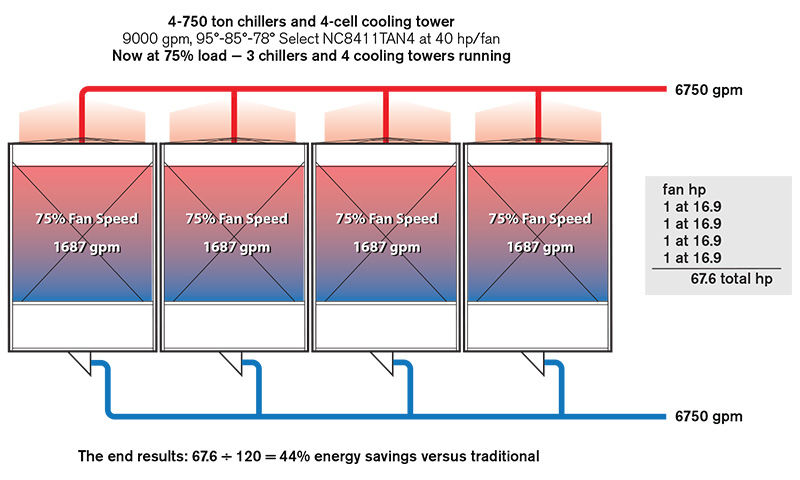冷却塔可变流量
如果冷却塔可以在可变流量条件下运行,则有很大的节能机会。改变冷却塔的流量(而不是冷却塔所服务的工艺的流量)不会影响工艺效率,因为该工艺仍可按照最高效的方式运行。
无论工艺流程有多少流量,可变流量都是最大限度提高安装的冷却塔容量效率的一种方法。
如果冷却塔可以在减少流量的条件下运行,那么流经三台运行冷却器的流量的 75% 将流经所有四个冷却塔单元。参见图 1。
不要改变冷却器的运行,冷却器仍应以最高效的方式运行。相反,应在所有四个冷却塔单元中持续使用所有可用水流(设计为 75%)。继续使用整个安装的湿润表面,以便每个冷却塔单元都能接收指定水流的 75%。
以 75% 速度运行所有四台风扇将产生与全速运行三台风扇相同的冷却能力。利用风扇定律确保以 75% 速度运行的风扇仅消耗 42% 马力,即每台略低于 17 bhp,所有风扇总共消耗 68 bhp。请注意,全速运行三台风扇消耗 120 bhp 是传统方法,但效率不高。如果冷却塔内能够实现适当的水分配,通过在所有冷却塔单元中循环 75% 流量可以节省 44% 的风扇能量。
其次,如果冷却塔能够循环 50% 流量且水分布良好,则在仅运行两台冷却器和两台冷凝器水泵时运行所有四座冷却塔应该可以。在这种情况下,以半速运行所有四台风扇可提供与全速运行两台风扇相同的冷却能力,但由于风扇定律,总制动马力降至每台风扇乘以四台风扇 20.5 马力,而全速运行两台风扇则为 80 马力。如果冷却塔内能够实现适当的水分布,则可能节省 75% 的风扇能量。
如前所述,用湿润表面换取风扇马力可以节省能源。对 Marley 横流冷却塔进行简单改造,通过改变与流量相关的活动喷嘴数量,可以在很大范围内改变流量。
安装 Variflow 喷嘴杯可有效地将热水分配盆分成外侧和内侧部分。这使冷却塔能够自动管理流量变化,确保保持活动喷嘴上方足够的压力。最重要的是,在整个填料中保持均匀的空气侧压降。
如下图所示,将流量降至最低流量会导致水盆中的水头下降,而 Variflow 喷嘴杯将完全激活。这样会完全切断水盆内侧喷嘴的水流。水盆后部的喷嘴现在已干燥。当冷却塔所服务的工艺以较低的负荷运行时,Variflow 喷嘴杯有助于在以较低的风扇速度运行冷却塔时提供一致的非设计性能和更高的节能效果。
下载 SPX 可变流量白皮书了解更多信息:




